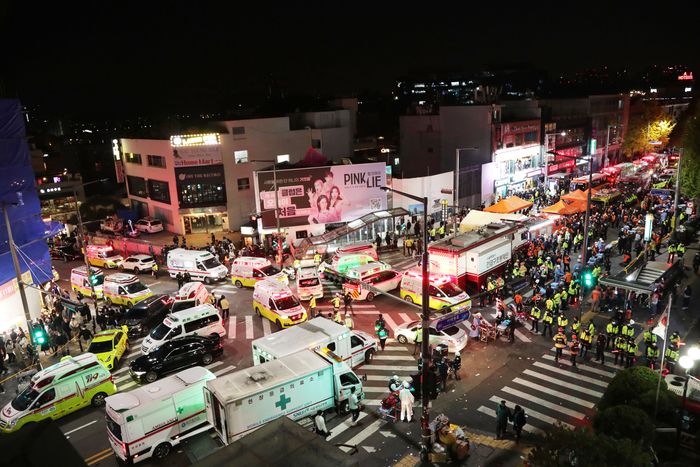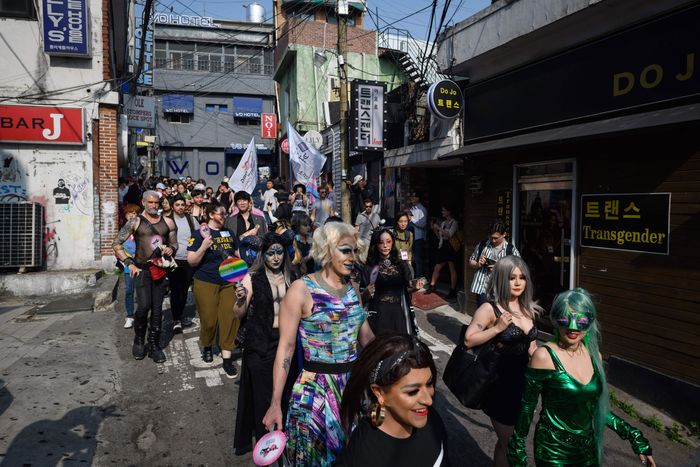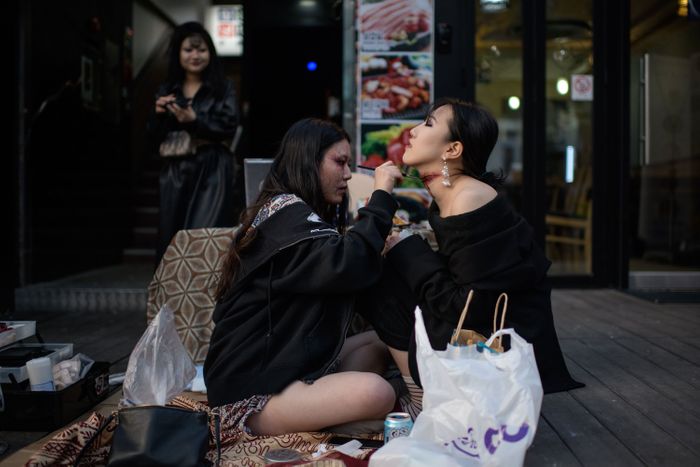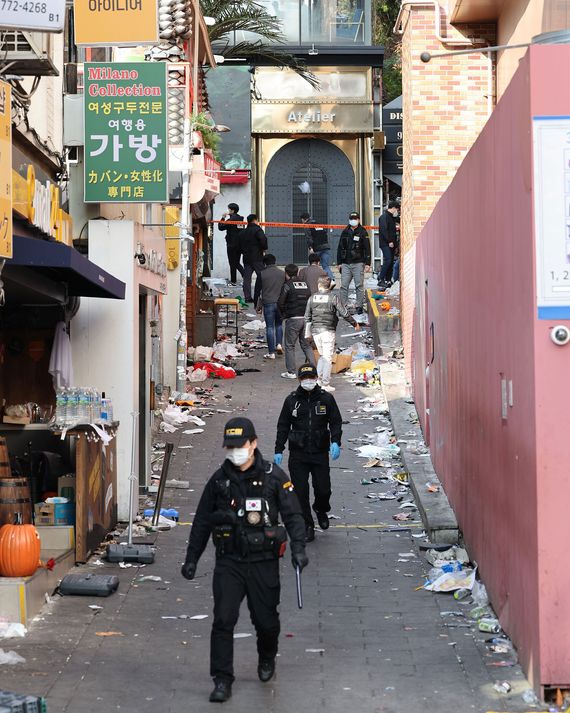

At the intersection in Itaewon where emergency vehicles clustered to give aid to the injured and transport those who had been killed in the Halloween crowd crush.
Photo: Jimmy Han/PentaPress/Shutterstock
Charlie Sim, the owner of the eponymous bar Charlie’s, was more than a little down when I talked to him. The middle-aged Korean business owner runs a cozy establishment the size of a living room just across the street from my old apartment in Hannam-dong, Seoul. It’s where I’ve spent countless hours drinking, hanging with friends, and listening to his life stories. From there, it’s only ten minutes on foot to the center of Itaewon, where a Halloween celebration last Saturday culminated in a massive crowd surge that killed 156 people and injured at least 151 more. The COVID pandemic had already ravaged small businesses like Charlie’s, but the recent tragedy has come as another blow.
What happened in Itaewon is the worst disaster in South Korea since the 2014 Sewol ferry sinking, which claimed more than 300 lives. Many are drawing comparisons to that accident because, in both cases, the victims were predominantly young and the state failed to adequately enforce basic safety regulations. In Itaewon, it’s become apparent that the government didn’t provide enough of a police presence or coordinate crowd-management plans despite the anticipated number of attendees. Far more officers, about 6,000 in total, were assigned to an anti-government protest downtown and to protecting the president, Yoon Suk-yeol, who moved his office to an area not far from Itaewon after his inauguration in May, than to the Halloween crowd (just 58 uniformed officers, according to the police). A log of emergency calls made several hours before the crush repeatedly warning of an impending disaster also seemed to have gone unheeded.
It’s terrible news for Itaewon, which has established itself as one of the capital city’s premier party districts over the past ten or so years. For decades associated with Yongsan Garrison, the large U.S. military base to its west established in 1945, Itaewon has long had a reputation as the domain of American soldiers seeking to unwind. With the large number of bars and brothels in the area that catered exclusively to foreign military personnel and expats, the neighborhood was coded, for many Koreans, as a dangerous place. Here, security was not just a local matter but sometimes blew up into national or geopolitical crises. In 1997, for instance, two American citizens were accused of stabbing a South Korean man to death inside the bathroom of a local Burger King (one of whom is still serving a 20-year sentence after a delayed sentencing). The controversy around the case centered on whether the investigation had been thoroughly conducted given one of the perpetrator’s ties to the U.S. military, and the story was even immortalized in the 2009 movie The Case of Itaewon Homicide.
But Itaewon was never just a seedy, military-dominated backwater. In the 1990s, the district’s famous Moon Night Club was a pilgrimage site for top dancers, many of whom attained success as celebrity musicians. The neighborhood also became a queer haven that was as welcoming to foreigners as Koreans (unlike the queer spaces in Jongno, another neighborhood in Seoul, which didn’t take a liking to non-Korean gays). In addition, it’s been an immigrant-friendly district in a city that has some of the priciest real estate in the world, providing affordable housing to low-income migrant workers. It’s also the country’s most important Muslim neighborhood, crowned by a mosque built in 1976 (and the city’s only one).
The Seoul Drag Parade, South Korea’s first drag parade, held in Itaewon in 2018.
Photo: Ed Jones/AFP via Getty Images
Back in 2005, when I worked briefly as a bartender at a small gay bar behind the Itaewon fire station, one of my cousins wanted to accompany me on a night out (without knowing my sexual orientation or where I was employed). But his mother put a stop to that idea. “I can’t possibly let you go to such a place,” she firmly announced, much to his disappointment. “It’s just not safe.”
That hint of criminality enhanced Itaewon’s allure for young people like my cousin as a distinctly exotic (and morally compromised) locale in the heart of Seoul. This is where some also felt they could test out new business ideas that might not fly elsewhere in the city. In the early aughts, the famous comedian Hong Seok-cheon (the first South Korean celebrity to come out publicly as gay) laid the ground for gentrification by opening a series of trendy restaurants specializing in non-Korean cuisines, and others soon followed. The U.S. military, meanwhile, started to relocate its base to the south of the city in 2013, taking 17,000 soldiers with it. Real-estate developers began muscling in, pricing out small businesses and putting up glitzy commercial buildings that rented for exorbitant amounts while the narrow, back-alley footprint of the streets remained the same. Seoul’s mayor this year even revived an old plan to turn Yongsan, next door, into a Silicon Valley–like tech hub.
All of this has meant that the neighborhood has rapidly developed over the past two decades from a quirky, rundown enclave patronized by South Korea’s expat community, queer residents, and migrant workers into an expensive nightlife playground for well-to-do Koreans and tourists. As Sim recalls, “I used to have all kinds of foreign customers. The teachers at the British School and the German School loved it here. But they are all gone. It’s now only Koreans who come to Itaewon, and they aren’t interested in a small, intimate place like mine.” The tiny bars and restaurants like Charlie’s that made the area vibrant in the first place now struggle to survive, if they haven’t already been replaced by generic franchises and restaurants with little character. When Seoul Pub, a grubby expat favorite for more than 20 years, went out of business in 2017, its owner told a local media outlet, “Big Korean companies want a presence in Itaewon because it’s a way of getting exposure to the larger numbers of foreigners that are coming here nowadays. Independent businesses like us can’t survive here anymore.” When his rent more than doubled, he closed the bar, and his lease was promptly taken over by a franchise restaurant.
On the heels of that shift to a more upscale nightlife scene, luxury condos — such as Nine One Hannam, where units go for anywhere from $6 million to double that for a penthouse — popped up, with two members of the K-pop group BTS moving in. If all goes according to plan for the construction industry and the speculators who have been buying up properties in the area, the southern half of Itaewon will be mostly demolished in the coming years to be filled up with yet more fancy apartment towers.
Partygoers putting on Halloween makeup in Itaewon, in 2018. The neighborhood has been the country’s main Halloween destination for less than a decade, and it’s only grown in popularity.
Photo: Ed Jones/AFP via Getty Images
Against this backdrop, the annual Halloween celebration, which began less than a decade ago, has morphed into the biggest in the country without any formal organization or coordinating body, and cementing Itaewon’s status as South Korea’s place to see and to be seen. The 2020 Korean television series Itaewon Class, based on the webtoon of the same title, paid tribute to this phenomenon, showcasing an entrepreneurial young man recently released from prison who stumbles in awe through an Itaewon Halloween parade and, in the course of the show, single-mindedly pursues his dream of starting a humble drinking hole in the neighborhood (as if such a thing were still possible). Initially, he symbolizes the kind of place Itaewon once was — one that welcomed outsiders and nurtured youthful dreams — and ends up a business magnate who runs a large restaurant franchise, ironically the very kind that is slowly taking over the area today.
Some foreigners attended the festival Saturday precisely because they were fans of the show. They found themselves chilled to the core. “I wanted to see the filming location of Itaewon Class and it was Halloween, so I went with a light heart on an impulse but instead felt death in the air,” one Japanese fan tweeted afterward, as quoted by the South Korean daily Seoul Shinmun.
The scene of the disaster was a narrow alley next to the Hamilton Hotel, between the major road where the Itaewon subway station is located and a roughly 300-meter-long, five-meter-wide pedestrianized strip — coveted real estate even within Itaewon. Lined with dozens of restaurants and bars, this small area has always been packed, even on a normal Saturday evening, so much so that my German sister-in-law, visiting four years ago from Munich, exclaimed on one such night out, “I thought Munich was a real city, but it’s not when compared to this!” Although the 130,000 people who gathered there Saturday may sound like a lot, some 200,000 were reportedly present for the same occasion in 2017. This past Halloween weekend, when crowds on either side of that alley began to make their way in, there was no way out for those who were caught in the middle.
Police officers examining the scene of the crowd crush two days after it occurred.
Photo: Yonhap/EPA-EFE/Shutterstock
Over the past several days, it’s become clear how rampant development contributed to the tragedy. On the corner, the Hamilton Hotel itself had built unpermitted structures, including a temporary metal wall, a booth, and a terrace, narrowing the lane even further in the choke point where so many lives were lost. The local district office allegedly ordered the Hamilton to remove these structures over the years, but the hotel kept on using the space, taking away precious breathing room that could have allowed more people to survive. Other businesses in the vicinity also constructed illegal terraces that jutted out into the street, making the walkway even narrower than it should have been. Again, there was no serious enforcement against these ad hoc additions, which compounded the fatalities that night.
Although left-wing political parties and South Korean media outlets are directing the bulk of the blame on the conservative government in power, Itaewon’s transformation into a heady party hub without proper infrastructure or safety protocols was not a single political party’s doing. If anything, it’s a classic example of how little the country as a whole prioritizes safety when it comes to economic development, whether it’s worker safety, street safety, or building safety.
Can old Itaewon, already under pressure, survive a catastrophe of this scale? Many are confident that young people will eventually return and that the neighborhood can hold on to the memory of the tragedy without becoming a ghost town again, as it was during the first couple of years of the pandemic. But that hope won’t do much to slow the trend toward denser, glitzier developments. Grand Ole Opry, a country-music bar and Itaewon institution since the 1970s, faces possible closure because of the planned “redevelopment” that envisions a big chunk of Itaewon razed and rebuilt from the ground up, which would take its building down with it. The bar’s aging but determined owner, Kim Sam-sook, insists, “They can try and take this place away from me. They don’t know whom they are dealing with!” Charlie Sim feels the same. “I am still running my business in the same place. I will do my best to hold on.”


